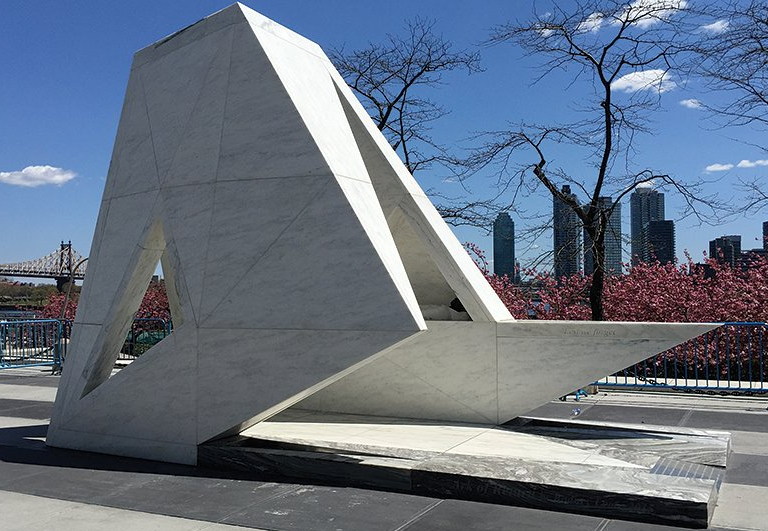The Ark of Return
The Return to the Ark Memorial is a sacred space designed to transport visitors psychologically and spiritually to a place where they can be recognized, educated, reflected, and recovered. The external structure of the memorial is constructed in a way that reflects the image of the ship, in recognition of the millions of Africans who were transported to different parts of the world by slave ships during the "Middle Passage". The map image depicting the "Triangular Slave Trade" influenced the use of triangles as the main element in designing the shape of the memorial. The memorial hall is also divided into three parts conceptually. Visitors should walk through the "Return Ark" to experience the three main elements of the interior space..[1]
In 2011, the Standing Commemorative Committee and UNESCO launched a design competition. Haitian-American architect Rodney Leon's "Return to Ark" was selected from 310 entries from 83 countries.[2]
Location : United Nations Visitors Plaza
1st Avenue and 46th Street
New York, NY 10017[3]
History
In more than 400 years, more than 15 million men, women and children have become victims of the tragic transatlantic slave trade, which is one of the darkest chapters in human history.
Every March 25th, the International Day of Remembrance for the Victims of Slavery and the Transatlantic Slave Trade provides an opportunity to honour and remeber those who suffered from cruel slavery.
In order to pay tribute to the victims more permanently, a permanent memorial was erected at the United Nations Headquarters in New York. The unveiling ceremony was held on March 25, 2015. The memorial invites people from all over the world to think about the legacy of the slave trade and fight today’s racism and prejudice.[4]
Background
Designed by the Haitian-American architect (Rodney Leon), the permanent memorial entitled "The Returning Ark" was unveiled on March 25, 2015. The design was selected through an international competition organized in cooperation with UNESCO and will be announced in 2013. Constantly reminding people of the courage of slaves, abolitionists and unsung heroes, these slaves helped end the oppression of slavery. It will also promote a better understanding of the contribution made by slaves and their descendants in their society.
The triangular pattern is reminiscent of the triangular routes of the slave trade that existed between continents. The external form reflects the image of a ship or a ship, which is a recognition of the millions of Africans transported around the world in slave ships. White is reminiscent of African spirituality. In times of death, sorrow and reflection, white clothing is considered the most appropriate.
The title of Returning the Ark is a deliberate contrast to the gate of no return that the enslaved Africans were driven back to America. The Gate of No Return is located in the museum and memorial " House of Slave " on the island of Gray, Senegal. It is believed that this is the location of the largest slave trading center on the coast of Africa. In 1978, the island was included in the UNESCO World Heritage List to remind people of the exploitation of mankind and a refuge for reconciliation.[5]
Monument Section
The Memorial contains three main elements, including:
- FIRST ELEMENT: “Acknowledge of the tragedy” is a three-dimensional map carved inside the memorial. The map highlights the African continent at the center of the slave trade and illustrates the global scale, complexity, and impact of the triangular slave trade.
- SECOND ELEMENT: “Consider the legacy” features a full-scale human replica carved from black Zimbabwean granite. This element illustrates the extreme conditions of transporting millions of Africans during the intermediate passage. The sculpture represents the spirit of men, women and children killed in the transatlantic slave trade.
- THIRD ELEMENT: “Lest we forget” is a triangular reflecting pool whose mission can commemorate the memory of millions of lives lost.[6]
Mission
The permanent memorial will remind people of the legacy of the slave trade. It will provide future generations with an understanding of the history and consequences of slavery and serve as an educational tool to raise awareness of current racism, prejudice and lingering consequences that continue to affect the descendants of victims .
The permanent memorial recognizes one of the most terrifying tragedies in modern history. This reminds slaves, abolitionists and unsung heroes of the heroic actions taken in severe danger and adversity.
The placement of the memorial at the United Nations Headquarters is an important symbol of the representatives of the world: to promote and maintain the dignity and value of all mankind-this is the core principle of the United Nations Charter.[7]
Reference
- ↑ The Ark of Return. Rodneyleon.com. Retrieved February 1, 2021
- ↑ A MEMORIAL TO HONOUR THE VICTIMS OF SLAVERY "THE ARK OF RETURN". Teterevufonds.lv. Retrieved February 1, 2021
- ↑ International Day for Remembrance of the Slave Trade and its Abolition. Unesco.org. Retrieved January 31, 2021
- ↑ A MEMORIAL TO HONOUR THE VICTIMS OF SLAVERY "THE ARK OF RETURN". Teterevufonds.lv. Retrieved February 1, 2021
- ↑ The Ark of Return.Un.org. Retrieved February 1, 2021
- ↑ International Day for Remembrance of the Slave Trade and its Abolition. Unesco.org. Retrieved January 31, 2021
- ↑ Permanent Memorial to Honour the Victims of Slavery and the Transatlantic Slave Trade at the United Nations.Un.org. Retrieved February 1, 2021


